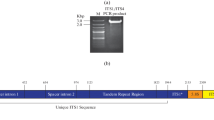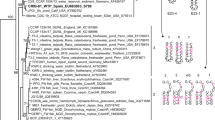Abstract
We report structural features and distribution patterns of 26 different group I introns located at three distinct nucleotide positions in nuclear small subunit ribosomal DNA (SSU-rDNA) of 10 Septoria and 4 other anamorphic species related to the teleomorphic genus Mycosphaerella. Secondary structure and sequence characteristics assigned the introns to the common IC1 and IE groups. Intron distribution patterns and phylogenetic relationships strongly suggested that some horizontal transfer events have occurred among the closely related fungal species sampled. To test this hypothesis, we used a comparative approach of intron- and rDNA-based phylogenies through MP- and ML-based topology tests. Our results showed two statistically well-supported major incongruences between the intron and the equivalent internal transcribed spacer (ITS) tree comparisons made. Such absence of a co-evolutive history between group I introns and host sequences is discussed relatively to the intron structures, the mechanisms of intron movement, and the biology of the Mycosphaerella pathogenic fungi.




Similar content being viewed by others
References
Bell-Pedersen D, Quirck SM, Aubrey M, Belfort M (1989). A site-specific endonuclease and co-conversion of flanking exons associated with the mobile td intron of phage T4. Gene 82:119–126
Bhattacharya D, Friedl T, Damberger S (1996) Nuclear-encoded rDNA group I introns: origin and phylogenetic relationships of insertion site lineages in the green algae. Mol Biol Evol 13:978–989
Bhattacharya D, Friedl T, Helms G (2002) Vertical evolution and intragenic spread of lichen-fungal group I Introns. J Mol Evol 55:74–84
Bhattacharya D, Reeb V, Simon DM, Lutzoni F (2005) Phylogenetic analyses suggest reverse splicing spread of group I introns in fungal ribosomal DNA. BMC Evol Biol 5:68
Burke JM, Belfort M, Cech TR, Davies RW, Schweyen RJ, Shub DA, Szostak JW, Tabak HF (1987) Structural convention for group I introns. Nucleic Acids Res 15:7217–7221
Cannone JJ, Subramanian S, Schane MM, Collett JR, D’Souza LM, Du Y, Feng B, Lin N, Madabusi LV, Muller KM, Pande N, Schang Z, Yu N, Gutell RR (2002) The comparative RNA Web (CRW): on line database of comparative sequence and structure information for ribosomal intron and other RNAs. BioMed Central Bioinform 3:1–31
Cech TR (1988) Conserved sequences and structures of group I introns: building an active site for RNA catalysis-a review. Gene 73:259–271
Costa M, Michel F (1995) Frequent use of the same tertiary motif by self-folding RNAs. EMBO J 14:1276–1285
Crous PW, Aptroot A, Kang JC, Braun U, Wingfieid MJ (2000) The genus Mycosghaerella and its anamorphs. Stud Mycol 45:107–121
Crous PW, Kang JC, Braun U (2001) A phylogenetic redefinition of anamorph genera in Mycosphaerella based on ITS rDNA sequence and morphology. Mycologia 93:1081–1101
Crous PW, Groenewald JZ, Pongpanich K, Himaman W, Arzanlou M, Wingfieid MJ (2004) Cryptic speciation and host specificity among Mycosphaerella spp. occurring on Australian Acacia species grown as exotics in the tropics. Stud Mycol 50:457–469
Dujon B (1989) Group I introns as mobile genetic elements: facts and mechanistic speculations-a review. Gene 82:91–114
Feau N, Hamelin RC, Bernier L (2006) Attributes and congruence of three molecular data sets: inferring phytogenies among Septoria-related species form woody perennial plants. Mol Phylogent Evol 40:808–829
Gargas A, Taylor JW (1992) Polymerase chain reactiori (PCR) primers for amplifying and sequencing nuclear 18 S rDNA lichenized fungi. Mycologia 84:589–592
Gibb EA, Hausner G (2003) A group I intron-like sequence in the nuclear small ribosomal subunit gene of the ophiostomatoid fungus Gondwanamyces proteae. Mycol Res 107:1442–1450
Goddard MR, Burt A (1999) Recurrent invasion and extinction of a selfish gene. Proc Natl Acad Sci USA 96:13880–13885
Goldman N, Anderson JP, Rodrigo AG (2000) Likelihood based-test of topologies in phylogenetics. Syst Biol 49:652–670
Guo F, Gooding AR, Cech T (2004) Structure of the Tetrahymena ribozyme: base triple sandwich and metal ion active site. Mol Cell 16:351–362
Gutell RR (1993) Collection of small subunit (16S- and 16S-like) ribosomal RNA structures. Nucleic Acids Res 21:3051–3054
Hall TA (1999) BioEdit: a user-friendly biological sequence alignment editor and analysis program for Windows 95/98/NT. Nucleic Acids Symp Ser 41:95–98
Hasegawa M, Kishino H, Yano T (1985) Dating the human-ape split by a molecular clock of mitochondrial DNA. J Mol Evol 22:160–174
Haugen P, Reeb V, Lutzoni F, Bhattacharya D (2004) The evolution of homing endonuclease genes and group I introns nuclear rDNA. Mol Biol Evol 21:129–140
Haugen P, Simon DM, Bhattacharya D (2005) The natural history of group I introns. Trends Genet 21:111–119
Hibbet DS (1996) Phylogenetic evidence for horizontal transmission of group I introns in the nuclear ribosomal DNA of mushroom-forming fungi. Mol Biol Evol 13:903–909
Holst-Jensen A, Vaage M, Schumacher T, Johansen S (1999) Structural characteristics and possible horizontal transfer of group I introns between closely related plant pathogenic fungi. Mol Biol Evol 16:114–126
Hufford L, McMahon MM, Sherwood AM, Reeves G, Chase MW (2003) The major clades of Loasaceae: phylogenetic analysis using the plastid matK and trnL-trnF regions. Am J Bot 90:1215–1228
Johansen S, Haugen P (1999) A complex group I intron in Nectria galligena rDNA. Microbiology 145:516–517
Johansen S, Haugen P (2001) A new nomenclature of group I introns in ribosomal DNA. RNA 7:935–936
Johansen S, Embley TM, Willassen NP (1993) A family of nuclear homing endonucleases. Nucleic Acids Res 21:4405
Jukes TH, Cantor CR (1969) Evolution of protein molecules. In: Munro HN (ed) Mammalian protein metabolism. Academic Press, New York, pp 21–132
Lehnert V, Jaeger L, Michel F, Westhof E (1996) New loop-tertiary interactions in self-splicing introns q subgroup 1C and ID: a complete 3D model of the Tetrahymena thermophila ribozyme. Chem Biol 3:993–1009
Li Z, Zhang Y (2005) Predicting the secondary structures and tertiary interactions of 211 group I introns in IE subgroup. Nucleic Acids Res 33:2118–2128
Machouart-Dubach M, Lacroix C, Vaury C, Feuilhade de Chauvin M, Bellanne C, Derouin F, Lorenzo F (2001) Nucleotide structure of the Scytalidium hyalinum and Scytalidium dimidiatum 18S subunit ribosomal RNA gene: evidence for the insertion of a group IE intron in the rDNA gene of S. dimidiatum. FEMS Microbiol Lett 208:187–196
Michel F, Westhof E (1990) Modelling of the three-dimensional architecture of group I catalytic introns based on comparative sequence analysis. J Mol Biol 216:585–610
Nikoh N, Fukatsu T (2001) Evolutionary dynamics of multiple group I introns jn nuclear ribosomal RNA genes of endoparasitic fungi of the genus Cordyceps. Mol Biol Evol 18:1631–1642
Nishida H, Tajiri Y, Sugiyama J (1998) Multiple origin of fungal group I intron located in the same position of nuclear SSU-rDNA gene. J Mol Evol 46:442–448
Notredame C, Higgins DG, Heringa J (2000) T-Coffee: a novel method for fast and accurate multiple sequence alignment. J Mol Biol 302:205–217
Perotto S, Nepote-Fus P, Saletta L, Bandi C, Young JPW (2000) A diverse population of introns in the nuclear ribosomal genes of Ericoid mycorrhizal fungi includes elements with sequence similarity to endonuclease-coding genes. Mol Biol Evol 17:44–59
Posada D, Crandall KA (1998) Modeltest: testing the model of DNA substitution. Bioinformatics 14:817–818
Roman J, Woodson SA (1998) Integration of the Tetrahymena group I intron into bacterial rRNA by reverse splicing in vivo. Proc Natl Acad Sci USA 95:2134–2139
Shimodaira H, Hasegawa M (1999) Multiple comparisons of log-likelihoods with applications to phylogenetic inference. Mol Biol Evol 16:1114–1116
Simon D, Moline J, Helms G, Friedl T, Bhattacharya D (2005) Divergent histories of rDNA group I introns in the lichen family Physaciaceae. J Mol Evol 60:434–446
Simon L, Lalonde M, Bruns TD (1992) Specific amplification of 18S fungal ribosomal genes from vesicular-arbuscular endomycorrhizal fungi colonizing roots. Appl Environ Microbiol 58:291–295
Suf SO, Jones KG, Blackwell M (1999) A group I intron in the nuclear small subunit rRNA gene of Cryptendoxyla hypophtoia, an ascomycetous fungus: evidence for a new major class of group I introns. J Mol Evol 48:493–500
Swofford DL (2003) PAUP*. Phylogenetic Analysis Using Parsimony (*and other methods), version 4. Sinauer Associates, Sunderland, MA
Tamura K, Nei M (1993) Estimation of the number of nucleotide substitutions in the control region of mitochondrial DNA in humans and chimpanzees. Mol Biol Evol 10:512–526
Templeton AR (1983) Phylogenetic inference from restriction endonuclease cleavage site maps with a particular reference to the evolution of humans and apes. Evolution 37:221–244
Verkley GJM, Priest MJ (2000) Septoria and similar coelomycetous anamorphs of Mycosphaerella. Stud Mycol 43:123–128
Verkley GJM, Starink-Willemse M, van Iperen A, Abeln EGA (2004) Phylogenetic analyses of Septoria species based on the ITS and LSU-D2 regions of nuclear ribosomal DNA. Mycologia 96:558–571
White TJ, Bruns T, Lee S, Taylor J (1990) Amplification and direct sequencing of fungai, ribosomal RNA genes for phylogenetics. In: Innis MA, Gelfand DH, Sninskv JJ, White TJ, (eds) PCR protocols: a guide to methods and applications. Academic Press, New York, pp 315–322
Wingfield MJ, Slippers B, Roux J, Wingfield BD (2001) Worldwide movement of exotic forest fungi, especially in the tropics and the Southern Hemisphere. BioScience 51:134–140
Woodson SA, Cech TR (1989) Reverse self-splicing of the Tetrahymena group I intron: implication for the directionality of splicing and for intron transposition. Cell 57:335–345
Zuker M (2003) Mfold web server for nucleic acid folding and hybridization prediction. Nucleic Acids Res 31:3406–3415
Acknowledgments
We are greatly indebted to Dr. Pascal Frey (Institut National de la Recherche Agronomique, Nancy, France) for constructive and helpful discussions. L. Bernier and R.C. Hamelin acknowledge support from a Fonds québécois de la recherche sur la nature et les technologies (FQRNT) team grant.
Author information
Authors and Affiliations
Corresponding author
Additional information
Reviewing Editor: Debashish Bhattacharya
Electronic Supplementary Material
Rights and permissions
About this article
Cite this article
Feau, N., Hamelin, R.C. & Bernier, L. Variability of Nuclear SSU-rDNA Group Introns Within Septoria Species: Incongruence with Host Sequence Phylogenies. J Mol Evol 64, 489–499 (2007). https://doi.org/10.1007/s00239-005-0309-7
Received:
Accepted:
Published:
Issue Date:
DOI: https://doi.org/10.1007/s00239-005-0309-7




